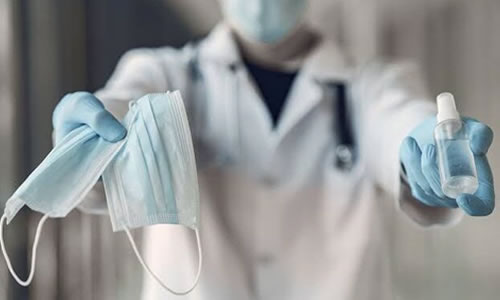You already know hospital PPE, but you still don’t know very well what they are for and how their daily use works? Are they really necessary?
Don’t worry, we’ll help you!
Due to the great exposure that health professionals have every day in the hospital environment, the application of this protective equipment has existed for a long time and is widely recommended by specialists.
In most cases in a hospital environment, the use of PPE is mandatory to protect employees and even patients from possible exposure to viruses, bacteria in order to prevent infections and other health complications.
Therefore, we have separated here everything you need to know about hospital PPE so that you have the best tips and information, before knowing which ones to implement and how to do it.
What are Hospital PPEs?
The acronym PPE refers to Personal Protective Equipment, used by the worker and intended to protect risks that could threaten safety and health at work, being applied to various segments of the industry and the provision of services. In the case of PPE Hospitalar, the devices obey safety and protection norms and rules specifically designed for professionals in the Health area.
Even if the activities do not offer a high risk of physical accidents, hospital environments are required to follow stricter safety standards to avoid contamination, which is only possible with the use of PPE.

Source: EPISEG
This is because even though there is no high risk of accidents, most hospitals, clinics, laboratories, health centers, and other similar environments, always offer a great risk of contamination and exposure of employees or patients.
This process happens due to the constant contact of the environment with substances and chemicals that can be toxic, or also with infected biological material, such as secretions, blood samples, urine, etc., common in these places.
to ensure everyone’s safety, it is essential that you follow all the recommended standards for each area.
It is important to clarify that the use of hospital PPE is not only essential in hospitals and doctors’ offices, but also in places such as dental clinics, examination laboratories, among others.
The use of hospital PPE in addition to being a preventive protection measure to preserve the health of professionals can also be an ally of managers and businessmen in the sector in reducing costs with possible problems that contamination by infectious diseases may cause to the institution or the employer.
In addition, when taking these preventive health protection measures, businessmen and managers in the sector demonstrate to their clients and patients that the services provided by the institution offer an environment with all the necessary care, guaranteeing the quality and safety of the services provided.
What are the types of Hospital PPE?
There are a wide variety of models of PPE for hospital use, their application will depend on the standards required for the performance of functions, but in general, they are used to avoid and reduce the risks of environment contamination and protect employees. The main types of hospital PPE are:
- Gloves
The gloves used by health professionals in the hospital environment prevent direct contact of the hands with patients’ biological materials, chemicals, infections, etc.
There are two main options for glove materials used in clinics and hospitals. The most common ones, made of latex and litrile rubber, are disposable and have more affordable prices compared to non-disposable gloves, made of different polymers that must be washed after each use and can be reused. There are also options for gloves that extend up to the forearm, necessary when there is a risk of contamination in that region of the body, such as: handling in formaldehyde tanks.
They are essential to cover most regions of the body of health professionals, leaving areas such as arms, shoulders, back, chest and legs protected from possible contagions, also the use of a cap protect other people in a certain biologically controlled environment.
There are aprons made of fabric (cotton and polyester), polyethylene TNT- non-woven fabric and impermeable polymers, which must be changed with some frequency to remain clean and intact in the case of reusable ones, and are used more in routine medical appointments, nurses, dentists and other health workers.
- Face protection mask
The protective mask is a PPE indicated to prevent contamination of employees and patients, especially in hospital environments that have a greater risk of contamination by viruses and bacteria that can be contracted through the air or microparticles from close contact with infected people.
The mask forms a physical barrier that prevents the virus from coming into contact with the individual’s mucous membranes. The use of protective masks associated with the correct measures of hygiene and social distance has been shown to be efficient in combating and spreading the new coronavirus.
According to experts, there is still no concrete data on the efficiency of the different types of masks. That’s because there are many different models and fabrics. For health professionals, the data show that the model N95 masks are better for protection than surgical ones. For the general public, evidence shows that multi-layered facial, surgical or cotton masks improve protection.
- Protective googles
This hospital PPE is used in situations where there is a risk of secretions or excretions from the patient that may splash or affect the employee in some way.
This equipment is essential to protect the employee’s eyes, as this is a very sensitive area and easily damaged without the use of protection.
Goggles, as well as all other PPE must comply with the established standards, some of which need to have side protection and an anti-fog device, as well as being transparent so as not to interfere with vision.
There are still many other types of hospital PPE, but the ones presented above are the most general, and are usually used in any type of clinic and hospital that works with quality.
Other PPE like: acrylic face shield, closed shoes, cap, among others are also seen in hospitals, but usually in more specific and specific situations.
Advantages of using Hospital PPE
Some of the biggest benefits of using hospital PPE are:
- Greater protection and safety of health professionals and patients;
- Reduction of expenses, because with the use of this protective equipment, your team will be less exposed to contamination, in addition to reducing possible costs with labor causes and medical-hospital care due to the lack of use of PPE in cases of contamination;
Have a clean environment and free of possible contaminants, contributing to the reputation of the hospital, clinic and other health facilities.
EPI Hospitalar – Where should I get the best ones?
CEPRALLI Trading Company excels in providing products of the highest quality, with guarantees of origin through certifications from regulatory bodies, such as ANVISA and INMETRO, as our suppliers follow the norms and standards of manufacture recommended by the respective competent bodies for safety of the user consumer.
Paying attention to reputation and good risk management for your company means investing in the security provided by professional and effective PPE, as this is the only way you will be able to keep your team of employees, customers and your patients protected.
In this moment of crisis in relation to the health of the population, the attention of all institutions is urgent in order to make the best and quickest way to overcome the problem arising from everyday life in the work environment.
CEPRALLI Trading Company is available to assist in the fight against the Corona Virus pandemic, as well as to assist the health sector and other segments that use this material, whether in this period of intense public health risk and in the standard scenario of professional activity.



